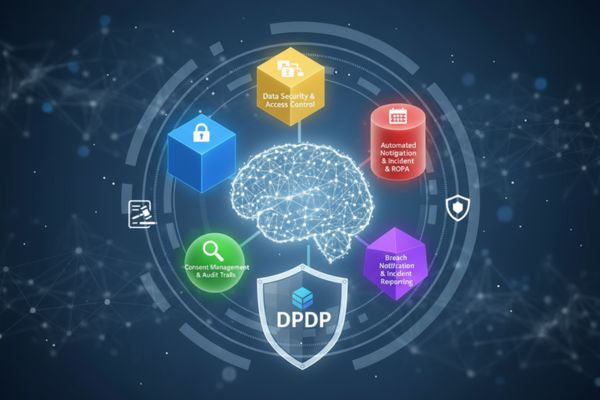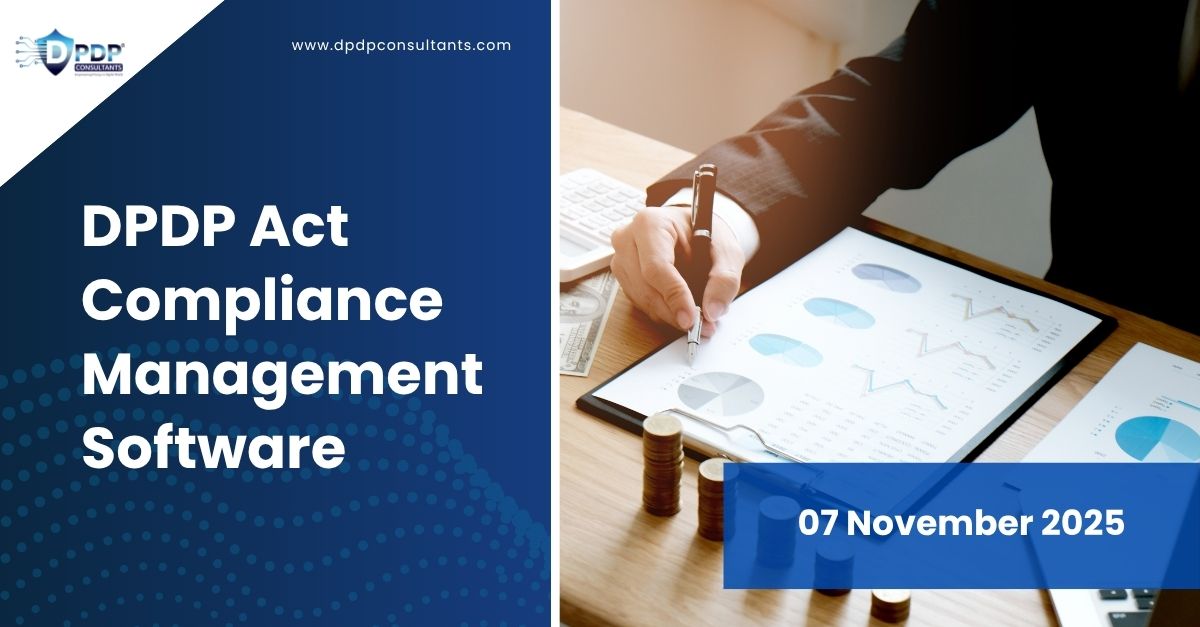Navigating the complex landscape of data protection is crucial for modern businesses. The DPDP Act stands as a pivotal regulation in this realm. It mandates stringent compliance for organizations handling personal data.
Understanding and implementing the DPDP Act is not just a legal obligation. It is a strategic necessity. Compliance ensures that businesses avoid hefty penalties and maintain customer trust.
This is where DPDP compliance management comes into play. It involves a comprehensive approach to meet the Act's requirements. Specialized software can significantly aid in this process.
DPDP compliance software offers tools for data mapping, risk assessment, and reporting. These features streamline compliance efforts. They also provide real-time monitoring and alerts for potential breaches.
The software integrates seamlessly with existing IT systems. It automates data protection processes, making compliance more efficient.
Organizations must appoint a Data Protection Officer (DPO). This role is crucial for overseeing compliance efforts.
Training and awareness programs are also essential. They ensure that all employees understand their roles in data protection.
In this guide, we explore how DPDP compliance management software can transform your compliance strategy.
Understanding the DPDP Act: Key Provisions and Requirements
The DPDP Act is designed to protect personal data and privacy. It aligns with global standards like GDPR. Understanding its core provisions is crucial for all organizations.
Firstly, the Act mandates obtaining explicit consent from individuals before collecting their data. This empowers people to control their data usage. Consent management becomes a critical area for compliance.
Secondly, organizations must appoint a Data Protection Officer (DPO). The DPO oversees compliance efforts, ensuring adherence to the Act’s provisions. This role is central to managing data processing activities.
Key requirements of the DPDP Act include:
• Explicit consent for data collection.
• Appointment of a Data Protection Officer.
• Comprehensive data processing records.
• Regular data protection impact assessments.
• Timely breach notifications to affected parties.
Additionally, organizations must conduct impact assessments. These assessments help identify risks associated with data processing activities. They are vital for managing potential vulnerabilities.

Failure to comply with the DPDP Act can lead to severe penalties. Thus, regular audits and updates of data protection practices are essential. By understanding these requirements, organizations can better align their operations with regulatory demands, safeguarding both their reputation and their customers' data.
Why DPDP Act Compliance Management Matters
DPDP Act compliance management plays a crucial role for organizations. It ensures adherence to data protection laws and enhances trust. Consumers are more likely to engage with compliant businesses.
Ignoring compliance can lead to significant penalties and reputational damage. Legal and financial repercussions can severely impact an organization’s operations. It underscores why compliance should be a strategic priority.
There are several key reasons why DPDP Act compliance management matters:
• Avoidance of legal penalties and fines.
• Enhancement of customer trust and loyalty.
• Prevention of data breaches and associated costs.
Effective compliance management contributes to a competitive advantage. By demonstrating commitment to data protection, organizations foster customer confidence. This trust is invaluable in today's data-driven economy, making compliance management not just a legal necessity, but a business imperative as well.
Challenges in Achieving Regulatory Compliance
Achieving regulatory compliance under the DPDP Act involves several hurdles. Navigating these challenges requires keen attention and strategic effort. Often, the complexity of the act itself poses difficulties for organizations.
Organizations face numerous obstacles in implementing compliance measures. Technical and human resources are often stretched thin. Keeping up with frequent regulatory changes can be especially taxing.
Key challenges in compliance include:
• Understanding complex legal terminology.
• Managing extensive data across diverse systems.
• Ensuring consistent employee training and awareness.
Addressing these challenges necessitates a focused approach. Proactive measures and clear communication within the organization are essential. By embracing technology and fostering a compliance culture, businesses can overcome these hurdles and align with regulatory standards effectively.
What is DPDP Compliance Management Software?
DPDP Compliance Management Software is a specialized tool designed to aid organizations in aligning with DPDP Act requirements. This software simplifies the process of monitoring and maintaining data protection obligations. It integrates seamlessly into existing infrastructure, making it an essential asset for modern businesses.
The software provides features that automate various compliance tasks. These include risk assessments, data mapping, and consent management. By using this software, organizations can streamline compliance processes efficiently.
Key functions of DPDP compliance software:
• Automates data protection processes.
• Monitors compliance breaches in real-time.
• Tracks and documents data processing activities.

Employing such software not only minimizes human error but also enhances data security. Organizations benefit by staying ahead of potential regulatory issues, thereby safeguarding their operations and reputation.
Core Features of DPDP Compliance Software
DPDP compliance software boasts a suite of features that make regulatory adherence manageable. These tools aid in ensuring all data handling complies with the DPDP Act’s stringent requirements.
A primary feature is data mapping, which involves identifying where personal data resides within an organization. This is crucial for maintaining transparency and accountability in data management. Accurate data mapping helps organizations respond efficiently to data subject requests.
Risk assessment tools are another key component. They help identify potential compliance risks by analyzing data processing activities. By doing so, they enable organizations to implement appropriate mitigation strategies. This proactive approach minimizes the risk of data breaches.
Additional features include:
• Real-time monitoring and alerts.
• Documented audit trails of data activities.
• Encryption and anonymization for data protection.

Moreover, the software provides robust reporting capabilities. These reports help demonstrate compliance to regulatory authorities. Detailed reports ensure that organizations can justify their data handling practices efficiently.
Other important features:
• Automated consent management processes.
• Support for incident response planning.
• Integration with existing IT infrastructures.
Overall, the software is designed for comprehensive data protection management. It aligns organizational practices with both legal and ethical standards, fostering trust and competitive advantage.
How DPDP Compliance Software Streamlines Compliance Processes
DPDP compliance software significantly enhances the efficiency of managing compliance processes. By automating routine tasks, it reduces the workload on compliance teams. Automation helps in ensuring that critical tasks are not overlooked.
This software provides real-time alerts for potential compliance issues. Timely alerts allow organizations to address problems before they escalate. This proactive approach reduces the risk of penalties and data breaches.
Centralized dashboards offer a comprehensive view of compliance status. They provide easy access to essential data and analytics, enabling informed decision-making. This transparency supports the identification of trends and potential risks.
Key benefits of streamlining include:
• Reduced manual errors.
• Faster response times to compliance issues.
• Improved resource allocation.

Additionally, the software integrates seamlessly with existing systems, ensuring consistency across organizational processes. This integration minimizes disruptions and facilitates smooth operations, enabling businesses to maintain focus on core activities. Overall, DPDP compliance software transforms regulatory management into a streamlined, efficient endeavor.
Integrating DPDP Compliance Software with Existing Systems
Integrating DPDP compliance software with current systems ensures smoother operations and better resource use. This integration supports seamless data exchange, boosting efficiency. Organizations can benefit from unified processes across departments.
Key advantages of successful integration include:
• Consistent data management.
• Reduced system redundancies.
• Enhanced data accuracy and reliability.

Moreover, this integration facilitates better collaboration between teams. It allows legal, IT, and business units to align efforts towards compliance goals. As a result, businesses can achieve more effective compliance management while maintaining operational flow. This synergy ensures that compliance efforts are not isolated but part of an organization's broader objectives.
Automating Consent and Data Subject Rights Management
Automating consent management is crucial in the realm of data protection. DPDP compliance software simplifies this task by ensuring that organizations secure explicit consent swiftly. This automation improves the accuracy and efficiency of consent records.
The management of data subject rights is equally vital. The software facilitates the seamless handling of requests such as data access and rectification. By automating these processes, organizations save time and reduce errors.
Benefits of automation in this area include:
• Quick response to data subject requests.
• Accurate logging of consent and rights management.
• Streamlined process for handling diverse requests.

Through robust automation, organizations enhance their ability to respect individual data rights. This fosters trust and demonstrates a commitment to legal and ethical standards. Consequently, automated consent management becomes a cornerstone of effective regulatory compliance.
Risk Assessment, Monitoring, and Reporting Capabilities
Risk assessment is a fundamental component of data protection. DPDP compliance software assists organizations in identifying potential vulnerabilities within their data processing activities. This proactive approach helps in preventing issues before they escalate.
Monitoring is another crucial function. The software continuously tracks compliance activities, providing real-time alerts on any deviations. It ensures that organizations remain compliant with the DPDP Act at all times.
The software's reporting capabilities are equally important. Detailed reports offer insights into compliance status and potential risks. These reports aid in decision-making and facilitate communication with stakeholders.
Key capabilities include:
• Real-time monitoring of compliance activities.
• Identification and assessment of data protection risks.
• Comprehensive reporting features for insights and decisions.

Through effective use of these tools, organizations can maintain robust data protection frameworks. This enhances their resilience against breaches and strengthens their overall compliance posture.
Ensuring Data Security and Breach Notification
Data security is a cornerstone of DPDP compliance management. The right software employs encryption and anonymization techniques to safeguard personal data. Such measures reduce the risk of unauthorized access and data breaches.
Breach notification is another critical feature. The DPDP Act mandates timely alerts to affected individuals and authorities in case of a breach. Compliance software automates this process, ensuring no delays in communication.
Key data security elements include:
• Encryption to protect sensitive information.
• Anonymization to minimize data exposure risks.
• Automated breach notifications for efficient response.
By implementing these security measures, organizations can maintain trust with stakeholders and avoid potential penalties.
Customization and Scalability for Different Industries
Every industry has unique compliance needs. DPDP compliance software offers customization to meet these varied requirements. This flexibility allows companies to tailor solutions that fit their specific operational dynamics.
Scalability is equally important as businesses grow. The software can scale up efficiently to handle increasing data volumes and evolving compliance needs.
Features include:
• Industry-specific templates for diverse sectors.
• Modular solutions to adjust to business size changes.
• Adaptable compliance strategies to meet specific requirements.
By customizing and scaling, businesses ensure effective compliance management across different operational contexts.
Best Practices for Effective DPDP Act Compliance Management
Adopting best practices ensures long-term success in DPDP Act compliance. Organizations need to focus on both strategic planning and everyday operations. Regular review and updates to data protection policies are crucial.
Training and awareness programs are vital for empowering employees with the right knowledge. These programs should cover the importance of data protection and practical compliance steps.
Key training topics include:
• Understanding personal data rights.
• Steps for secure data handling.
• Recognizing compliance risks and their mitigation.
Collaboration is another cornerstone of effective management. Legal, IT, and business teams need to work closely to ensure seamless compliance. This cross-functional cooperation builds a robust compliance framework.
Key collaboration strategies include:
• Frequent inter-departmental meetings for alignment.
• Sharing insights on regulatory changes.
• Joint development of compliance strategies and responses.
By following these best practices, organizations can enhance their compliance posture and protect personal data effectively.
Choosing the Right DPDP Compliance Management Solution
Selecting the right compliance management software is essential for effective DPDP Act compliance. Start by understanding your organization's specific needs and goals.
Consider the following factors when evaluating solutions:
• Ease of integration with existing systems.
• Customization options to fit industry-specific requirements.
• Comprehensive reporting and analytics capabilities.
Evaluate potential software through demonstrations and trials. Engage stakeholders from various departments for feedback. A well-chosen solution will streamline compliance efforts, enhance data protection, and support your regulatory obligations effectively.
The Future of Regulatory Compliance and Data Protection in India
India's regulatory landscape is rapidly evolving, emphasizing data protection and privacy. Organizations must stay abreast of changes in compliance regulations and technology advancements.
Key trends to watch include:
• Increased emphasis on individual data rights.
• Integration of AI in compliance management.
• Stricter enforcement of data protection laws.
Adapting to these trends will be essential for maintaining compliance and protecting customer data. As India continues to align its laws with global standards, staying informed and proactive will be vital for businesses seeking a competitive edge.
Conclusion: Building Trust and Competitive Advantage with DPDP Compliance
Achieving DPDP Act compliance is not just about avoiding penalties. It represents an opportunity to build trust with customers through responsible data stewardship.
By leveraging DPDP compliance software, organizations can efficiently manage compliance, safeguard data, and foster customer loyalty. Adhering to the DPDP Act demonstrates a commitment to privacy, which can differentiate a business in a competitive market. As data protection becomes increasingly crucial, organizations with solid compliance strategies will likely enjoy enhanced reputations and competitive advantages.












